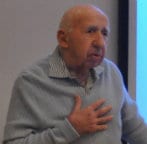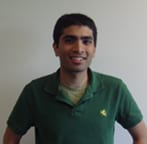The Beginnings of the MPH Program:
Nilay Shah: So, as we know, you started Northwestern University’s MPH program, and I am right now working my way through it. I would like to ask you how it all got started; what were things like in the beginning?
Dr. Jeremiah Stamler: Well, when the dean first interviewed me, we agreed that we had a limited amount of money for this new department and thus would have a limited program. We would teach medical students and that would be our main function. There wouldn’t be any graduate programs in statistics, epidemiology, or preventive medicine, just teaching medical students the more-or-less required materials in the aforementioned subjects. Then one day, I got a communication from one of the deans on the north [Evanston] campus, with a stack of materials, requesting me to go over these and see if we could do anything.
The materials were from a young lady named Kathryn Andolsek, whose name I guess I will never forget. She was in the six-year undergraduate MD program and through her father was in touch with facets of public life in Washington, [D.C.], and as a result she had become interested in public health. Ms. Andolsek decided she wanted to get an MPH while she was in medical school, so she sat down with all the Northwestern catalogs that might remotely be related to subjects in public health, found courses, put them together into a program, and proposed to the dean at the Evanston campus that she include this in her curriculum during the six years. That way, when she graduated, she would get not only an MD, but also an MPH (dual) degree.
As I read this through, I said, “I’ve got to meet her; she must be a remarkable young lady!” And as a matter of fact, she was! I said to her, “We’ll see what we can do.” I literally threw together a program. It was not a program that was comprehensive, with a lot of courses, it was not in-depth, it did not really compare favorably with any other such programs in schools of public health around the country at the time, but it was at least a minimal program. I submitted it to the dean of the medical school and the dean of graduate studies in response to Ms. Andolsek’s specific proposal. I proposed we do this, and as we go along, we accrue experience and eventually we make it a full-fledged program that we’re not ashamed of! So that’s how the program started, and it went on for several years that way.
When Phil Greenland [MD] became chairman of the department [of Preventive Medicine] in 1991, there was a hiatus while it (the program) was put on hold for an in-depth review on the possibility of a full-fledged master’s program in public health. There was a decision to have a full-fledged program, with tuition for it and everything else, and that’s how we got to what we have now. So the transition was made from nothing to something—and then on to something that’s first-rate, outstanding, and certified.
NS: Absolutely. As you were developing this program, did you meet obstacles? Did you have people who did not share your vision?
JS: Well, the obstacles were that we were a small department, half a dozen of us. We had huge research grants, we were up to our eyeballs in research, and we didn’t have a whole lot of time to develop teaching programs. We had a required course in public health, which was a big chore every spring, and a small group of us did a good part of the teaching. Taking on the additional teaching of courses to make up a minimal MPH program was really quite difficult. But we managed and a number of people got the degree.
NS: I think you may have heard that Northwestern University is planning to develop an Institute of Public Health (IPHAM).
JS: That’s right, how about that? You never know when you drop a seed on the soil what exactly is going to happen!
The Importance of Mentors:
NS: As a medical student I am learning very quickly, along with my peers, that it’s very important in medical education to have mentors who can guide us and help us along our way. Can you tell me a little bit about any mentors that you have had?
JS: First of all, I want to underscore the importance of what you’ve just said. In the computer age, you get the idea that the most brilliant stuff is available on the computer. The whole idea of living teachers is presumably archaic; history has passed us by. I don’t agree with that. My personal experience is the contrary. I went to a not very well endowed medical school, which later became New York Downstate in Brooklyn. During World War II it was even less well endowed because many of the most capable people went into to the armed forces. So, we had preclinical courses—I had been a Columbia pre-med, I had taken graduate courses with brilliant teachers—preclinical courses that were, from my point of view, all too often mediocre and uninspiring. However we had one outstanding professor in the preclinical years, who was professor and chair of pathology, Jean Oliver, who in his research teased out individual nephrons from kidneys, and, working with Thomas Addis [MD] in California, collected urine from individual nephrons and sent them to Addis for biochemical analyses. He was an extraordinary person. He was not only an outstanding researcher, [but also an] excellent teacher, lecturer, and a very positive, forward-looking, vigorous, progressive human being in terms of what was going on in society. He made a tremendous impression on me.
NS: Along those same lines, what do you think makes a good mentor to up-and-coming students?
JS: Well, I once read an article about public speaking, and the article began—“if you’re totally uninspired, if you’re totally disinterested, stay home! Don’t go out and talk.” So first you have to have a person who is intellectually alive in relation to a subject enabling mentor and student really to mesh. I think that’s very important.
Secondly, the mentor has to be a person who is interested in younger people, who is willing and eager to communicate with younger people, spend time with younger people—not just in teaching a whole class of second-year medical students, but also ready to devote time to younger people individually and in small groups. From the point of view of a senior person, relating to one, two, three, or more young people, maybe I can’t be as productive research-wise, the younger people may not be able to move along quite as fast as I’m prepared to—but done wisely, often I can increase my productivity. From the point of view of a wise—I think that’s a good word to use—a wise older person developing that kind of relationship with younger people can be highly productive. And that’s the way I’ve done it for decades, right up to and including today! I was just reviewing a paper of a distinguished professor, Dr. Nakamura, Chairman of his department in Japan, [and] he’s not a youngster, he’s middle-aged. So, you can have all kinds of fruitful relationships with all kinds of wonderful people. It’s fun and productive and simulating! That’s why I’m still working.
NS: Thank you, Dr. Stamler, for taking the time to talk with the NPHR.
About the Interview
Jeremiah Stamler, MD, is Professor Emeritus in the Department of Preventive Medicine at Northwestern University. He developed the school’s Master of Public Health Program (MPH) and is an authority on the role of salt and fatty foods in hypertension and cardiovascular disease. This is part two of a two-part interview, with part one published in the Fall 2013 edition of the NPHR.
Nilay Shah is a graduate of the Feinberg School of Medicine. His public health interests are in cardiovascular epidemiology and outcomes research.


